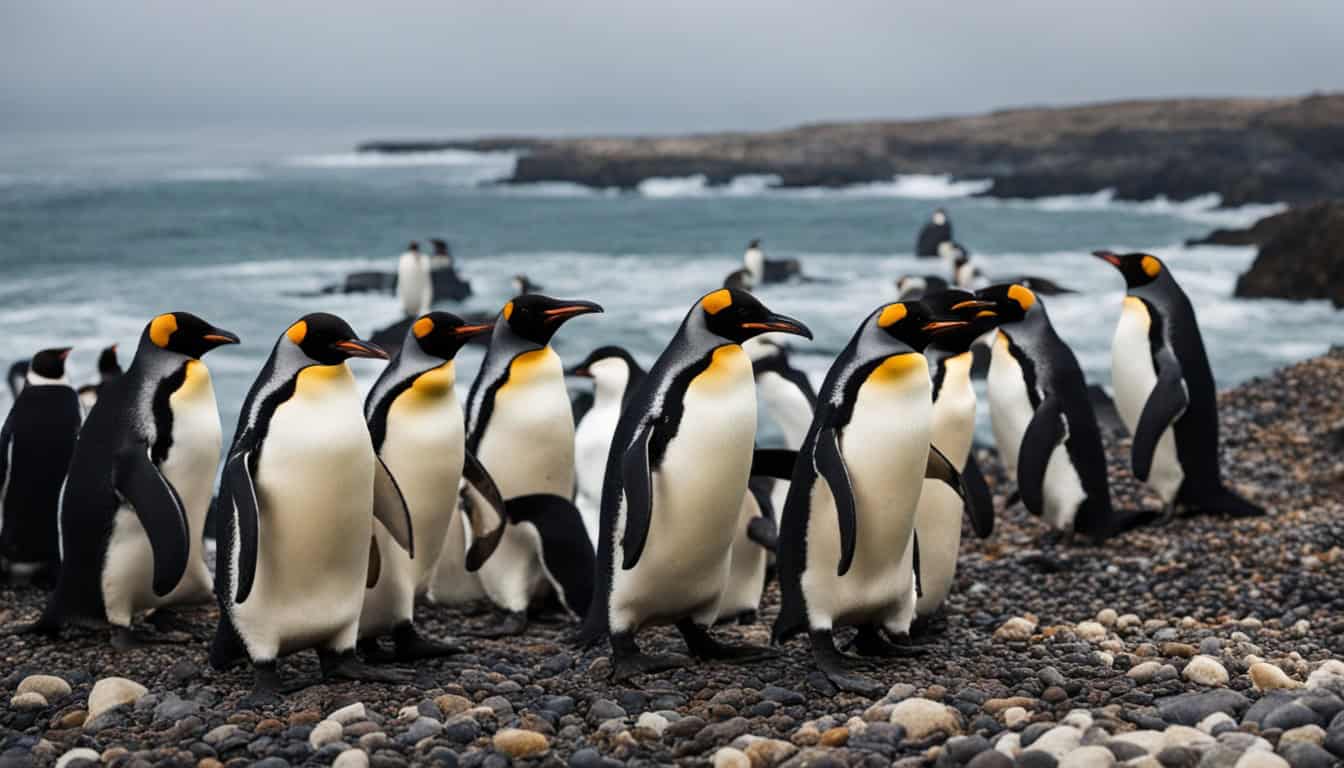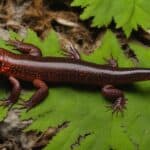Despite penguins being popular in the USA, there are none living in the wild here. They come from the southern hemisphere. The closest wild penguin groups are in South America and Antarctica. In the US, you can only see them in places like zoos and aquariums.
Want to help American penguins? You can symbolically adopt one through conservation programs. They offer interactive maps to show penguin habitats globally. This makes people more curious and helps them feel connected to penguins worldwide.
The History of Penguin Habitats
The story of penguin habitats is filled with big changes over time. Exploring the start, movement, and making of their homes shows how clever penguins are. They’ve learned to live in many different places.
Origins of Penguins
It was about 22 million years ago when penguins first showed up. This happened in the warm, lush areas of Australia and New Zealand. And no, they weren’t in cold Antarctica yet. It was great for them there with lots of food and nice weather.
Migration Patterns
Penguins moved around a lot over millions of years. Research tells us that emperor and king penguins made their way to colder lands. They ended up in places like the sub-Antarctic and Antarctica. A big waterway called the Drake Passage opening up about 12 million years ago helped them get to these places. It made it easier for them to travel all around the Southern Ocean.
Colonization of New Habitats
Living in many different places was key for penguins. They were able to change and adapt, letting them settle in new lands. This came about by mixing with different penguin kinds and adjusting to various climate and salt levels. Thanks to this, penguins have really made a name for themselves in the Southern Hemisphere.
| Period | Event | Impact |
|---|---|---|
| 22 million years ago | Penguins originated in Australia and New Zealand | Initial establishment of penguin species in temperate regions. |
| 12 million years ago | Opening of the Drake Passage | Facilitated penguin migration across the Southern Ocean. |
| Ongoing | Introgression events | Diversification and adaptation to new habitats. |
Penguin Populations in the Southern Hemisphere
The Southern Hemisphere shines with its many penguin types. This makes it a key spot for penguin studies. Penguins can live in many places, from warm beaches to cold waters. Here, we’ll look at penguins in three main areas: Antarctica, South America, and Australia-New Zealand.
Antarctica: The True Native Home
Antarctica is the birthplace of many penguin kinds. It’s rich in emperor and Adélie penguins. These penguins are experts in the icy environment. They have very special skills and features. These help them survive the harsh cold, leading to many penguins living there.
Penguins in South America
South America is another place with lots of penguins. The Galápagos penguin is well known, as are the Humboldt and Magellanic penguins. They can be seen along the shores of Chile and Argentina. Even so, these penguins are in danger from lost homes and changes in the weather. They play a big role in the area’s variety of life.
Penguin Species in Australia and New Zealand
Australia and New Zealand have their own special penguins. This includes the Little Blue Penguin and the Yellow-eyed Penguin. Penguins here show they can live in a variety of spots, from warm coastal areas to islands. People are working hard to keep these penguins safe from harm and the climate.
Penguin Sightings in the United States
Penguins are usually found in the Southern Hemisphere. But, in some rare cases, people in the United States have spotted these birds on their shores. These sightings are quite unusual and often make people wonder how the penguins got there.
Notable Sightings in Alaska
In Alaska, there have been some very interesting Alaska penguin incidents. Most of these sightings include Humboldt penguins. They are from the coasts of Peru and Chile. Experts suggest these penguins didn’t travel to Alaska on their own. Instead, they may have been let go from fishing boats coming from South America by mistake or on purpose.
Incidents in the Pacific Northwest
There have also been rare penguin sightings in the Pacific Northwest. Just like in Alaska, these sightings mostly involve Humboldt penguins. It’s believed they were brought on ships and ended up being set free. This led to them mingling with the local wildlife occasionally. These surprises are interesting to bird experts and the public. They show how wildlife and human activities can mix in unexpected ways.
Below is a table with details about some of these penguin sightings in the United States:
| Location | Date | Species | Possible Cause |
|---|---|---|---|
| Alaska | 2021 | Humboldt Penguin | Release from Fishing Boats |
| Pacific Northwest | 2018 | Humboldt Penguin | Accidental Release |
Even though these events are uncommon, they show interesting connections between wild places and human activities. It’s a reminder of the value of keeping an eye on how wildlife moves. This helps in protecting these unique animals.
Are there any native penguins in the USA?
It’s key to note that no penguin species call the United States home. If people see penguins in the US, it’s usually because of human actions. Other birds, like murres and auks, fill the penguins’ role in the North. So, when penguins are seen in the US, it’s often a mistake or from birds that got away.
People might still hope to find penguins native to the US, but this isn’t likely. The North American environment doesn’t naturally fit penguin needs. Murres and auks are what really belong in *North American penguin habitats*. When penguins are spotted here, it’s usually because of people, not because they live here.
The Humboldt Penguin Mystery
The mystery of the Humboldt penguin has everyone puzzled. These amazing birds normally live along the coast of Peru and Chile. But lately, they’ve been seen much farther north, way out of their usual range.
Penguins on Fishing Boats
Some think fishing boats are the key. It’s possible these penguins were kept as mascots on ships. Once at sea, they ended up in the colder northern areas. After sailing with humans for a while, they were often set free.
Accidental Introductions
Accidents may also be a cause. Efforts were made to help Humboldt penguins live in the north, but it hasn’t gone well. They seem to appear in places like Alaska more because of boat releases than because of natural movements or zoo breaks.
The table below summarizes these intriguing scenarios associated with the Humboldt penguin mystery:
| Scenario | Description | Outcome |
|---|---|---|
| Penguins on Fishing Boats | Kept as pets aboard fishing vessels and later released | Observed in unexpected northern waters |
| Accidental Introductions | Attempts to establish colonies in the Northern Hemisphere | Failed efforts, but occasional sightings due to releases |
The Role of Zoos and Aquariums
Zoos and aquariums do a lot for penguin conservation. They give penguins a safe place away from wild dangers. Plus, they teach the public why saving penguins is important with educational programs.
Captive breeding is key for these places. They pick the right penguins to breed, avoiding problems like inbreeding. This keeps penguin populations healthy in the long run.

People in America get to know penguins from the Southern Hemisphere thanks to zoos and aquariums. These birds aren’t native here, but these places let us learn and care for them. So, everyone can help in keeping penguins safe everywhere.
Zoos and aquariums also make learning fun with events and workshops about penguins. They work with others worldwide to help save penguins from disappearing forever. Together, they share important knowledge and work on big projects to protect penguins.
“You never forget your first close encounter with a penguin at the aquarium. Their charm and uniqueness inspire a commitment to conservation that lasts a lifetime.”
In the end, zoos and aquariums bring people and penguins together. They help start a big effort to save penguins. This work goes beyond the zoo walls, involving everyone in helping penguins on our planet.
Differences Between Penguins and Similar Northern Hemisphere Birds
In the Northern Hemisphere, we don’t find penguins natively. But, birds like murres and auks look a lot like penguins. They live in similar places and do similar things, causing some confusion. It’s key to tell these birds apart, even if they seem alike to many.
Murres and Auks: Lookalikes
Murres and auks look a lot like penguins from the South. They’re known for their black-and-white appearance. These birds are excellent divers, just like penguins, for hunting underwater. They mainly live in the cold, northern parts. Here, along rough coastlines and on islands, they find their homes.
- Murres: They often nest on narrow cliffs, much like penguins gather in large groups.
- Auks: Found all over the north, auks are great swimmers and divers. They act similar to penguins.
Understanding the Ecological Niche
Murres and auks in the north have a special place. They dive in cold waters to find food, just like penguins. They’ve adapted well to their environments, where fishing is plenty. But, they face different challenges, like predators and weather, compared to penguins. These differences affect how they live and survive.
“The absence of certain natural predators like bears in the Southern Hemisphere has allowed penguins to flourish in areas where murres and auks might face significant threats.”
Learning about these birds’ unique traits is fascinating. It shows how each one has found its own way to live in its special part of the world.
Climate and Habitat: Why Penguins Don’t Thrive in the Northern Hemisphere
Penguins face major challenges in the North. The penguin climate habitat struggles with large, unpredictable changes in ocean temperatures. These shifts are tough on penguins, who prefer steady, cold waters in the South.
Predators also make the North a tough spot for penguins. Northern Hemisphere habitat unsuitability is enhanced by polar bears and big land mammals. Aggressive bird species there add to the danger. Such predators are rare in the South, making the North even more dangerous for penguins.
Unstable ocean temperatures are another problem. The penguin climate habitat is very sensitive to temperature changes. These changes quickly impact their food and nesting areas. Penguins need stable, cold waters to survive, something the North often lacks due to climate shifts and human actions.
The South is really the best place for penguins to do well. The North simply has too many hurdles: changing temperatures, predators, and a tough environment. This makes survival hard for penguins in the Northern Hemisphere.
Conservation Efforts and Their Impact
Conservation efforts are vital for penguin populations worldwide. They face challenges such as climate change, pollution, and habitat loss. These issues hit the African and Galapagos penguins hard, leading to their numbers dropping. To save them, we need to fight these threats and ensure their future.
Protecting where penguins breed is a key step. By keeping their breeding grounds safe, these birds can keep laying eggs and raising chicks. It’s also crucial to manage fishing better, to avoid accidentally catching penguins. Using fishing methods that care for the sea and its creatures is important.
It’s crucial to teach people why protecting penguins is so important. Education shines a light on the dangers of climate change and pollution for these birds. It also shows how everyone can help. By making the connection between people and penguins stronger, support for conservation grows.
FAQ
Are there any native penguins in the USA?
No, the USA doesn’t have native penguins. They all live in the Southern Hemisphere. The closest wild penguins are in South America and Antarctica.
Where did penguins originally come from?
Penguins started in Australia and New Zealand’s coasts 22 million years ago. This was during the warm Miocene Epoch.
How did penguins spread to other areas?
After the Drake Passage opened 12 million years ago, penguins could move more freely. They traveled to areas like the sub-Antarctic and Antarctic waters.
Where are penguins primarily found today?
Today, most penguins live in the Southern Hemisphere. They are in places such as Antarctica, South America, Australia, and New Zealand.
Have penguins ever been seen in the United States?
Yes, there have been sightings in Alaska and the Pacific Northwest. But these were likely because of people, not natural journeys.
What is the Humboldt Penguin Mystery?
The Humboldt Penguin Mystery is about seeing these penguins in the north. They might have ended up there by mistake or on purpose from fishing boats from Peru and Chile.
What role do zoos and aquariums play regarding penguins in the US?
Zoos and aquariums teach us about penguins and help with their conservation. They also breed penguins to keep their populations healthy.
What birds in the Northern Hemisphere are commonly mistaken for penguins?
In the North, murres and auks look like penguins. People often mix them up due to similar looks and what they do in the ecosystem.
Why don’t penguins thrive in the Northern Hemisphere?
The North’s weather and living situations don’t suit penguins. Changes in the sea and the existence of certain predators make it hard for them to live there.
What are the major focuses of penguin conservation efforts?
Conservation works to protect where penguins breed. It also controls fishing to lower unwanted catches and teaches people why saving penguins is crucial.







